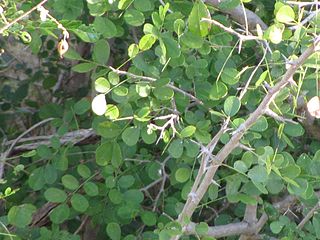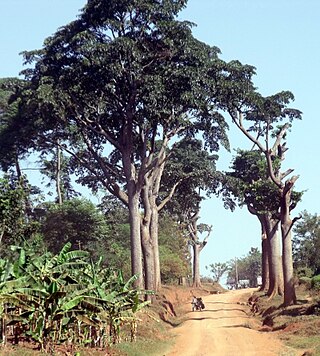
Dalbergia melanoxylon is a flowering plant in the family Fabaceae, native to seasonally dry regions of Africa from Senegal east to Eritrea and south to the north-eastern parts of South Africa. The tree is an important timber species in its native areas; it is used in the manufacture of musical instruments and fine furniture. Populations and genomic resources for genetic biodiversity maintenance in parts of its native range are threatened by overharvesting due to poor or absent conservation planning and by the species' low germination rates.
Wildcrafting is the practice of harvesting plants from their natural, or 'wild' habitat, primarily for food or medicinal purposes. It applies to uncultivated plants wherever they may be found, and is not necessarily limited to wilderness areas. Ethical considerations are often involved, such as protecting endangered species, potential for depletion of commonly held resources, and in the context of private property, preventing theft of valuable plants, for example, ginseng.

Nauclea is a genus of flowering plants in the family Rubiaceae. The species are evergreen trees or shrubs that are native to the paleotropics. The terminal vegetative buds are usually strongly flattened. The generic name is derived from the Ancient Greek words naus, meaning "ship" and kleio, meaning "to close". It refers to the resemblance of the cells of the capsule to a ship's hull.
Afrocarpus dawei is a species of conifer in the family Podocarpaceae. It is native to Africa, where it occurs in the Democratic Republic of the Congo, Tanzania, and Uganda.

Triplochiton scleroxylon is a tree of the genus Triplochiton of the family Malvaceae. The timber is known by the common names African whitewood, abachi, obeche, wawa, ayous and sambawawa. The tree is the official state tree of Ekiti State, Nigeria.
Brachystegia angustistipulata is a species of plant in the family Fabaceae. It is found in Democratic Republic of the Congo and Tanzania.

Pericopsis elata is a species of flowering plant in the family Fabaceae and is known by the common names African teak, afromosia, afrormosia, kokrodua and assamela.
Pterygota bequaertii is a species of flowering plant in the family Malvaceae. It is found in Cameroon, Republic of Congo, Democratic Republic of the Congo, Ivory Coast, Gabon, Ghana, and Nigeria. It is threatened by exploitation as a timber tree. The wood has the trade name koto.
Guibourtia arnoldiana is a species of Guibourtia in the family Fabaceae, native to tropical western Africa from the Gabon, Republic of the Congo, western Democratic Republic of the Congo, and northernmost Angola (Cabinda).
Isolona congolana is a species of plant in the Annonaceae family. It is found in the Democratic Republic of the Congo and Uganda. It has also recently been found in southern Africa.

Lovoa trichilioides, also called African walnut, Congowood, dibetou or tigerwood, is a species of plant in the family Meliaceae. It is found in Angola, Cameroon, the Republic of the Congo, the Democratic Republic of the Congo, Ivory Coast, Gabon, Ghana, Liberia, Nigeria, Sierra Leone, Tanzania, and Uganda. It is threatened by habitat loss. Germination success is somewhat limited by short-lived seeds which are heavily predated. Exploitation rates are high. It is one of the two principal timber species in Congo.

Milicia excelsa is a tree species from the genus Milicia of the family Moraceae. Distributed across tropical Central Africa, it is one of two species yielding timber commonly known as African teak, iroko, intule, kambala, moreira, mvule, odum and tule.
Terminalia ivorensis is a species of tree in the family Combretaceae, and is known by the common names of Ivory Coast almond, idigbo, black afara, framire and emeri.

Turraeanthus africanus is a species of plant in the family Meliaceae, also known by the common names avodiré, apeya, engan, agbe, lusamba, wansenwa, African satinwood, and African white mahogany.

Iroko is a large hardwood tree from the west coast of tropical Africa that can live up to 500 years. This is the common name for the genus Milicia, in which there are two recognized species, which are closely related: Milicia excelsa and Milicia regia.

Diospyros crassiflora, commonly known as Gabon ebony, African ebony, West African ebony, and Benin ebony is a species of lowland-rainforest tree in the family Ebenaceae that is endemic to Western Africa. It is named after the West African state of Gabon, though it also occurs in Cameroon, Central African Republic, Republic of the Congo, Democratic Republic of the Congo, Equatorial Guinea and Nigeria.

Strombosia pustulata is a species of tree in the family Olacaceae. It is native to the rainforests of tropical West and Central Africa. Common names for this tree include itako in Nigeria, afina in Ghana, poé in Abé spoken in Côte d'Ivoire and mba esogo in Equatorial Guinea.

Gilbertiodendron dewevrei is a species of tree in the family Fabaceae, native to tropical rain forests in Central Africa. It is often the dominant tree species of the Guineo-Congolian rainforest. The timber is traded as limbali, and is used for construction, flooring and railway sleepers. It is also used for making boats, furniture, tool handles and joinery and for making charcoal.

Brachystegia laurentii, a plant in the family Fabaceae, is a species of large tree found in western Cameroon, Gabon, Equatorial Guinea, the Democratic Republic of the Congo and the Republic of the Congo. It has a dense, umbrella-shaped crown. The wood is known as bomanga and has many uses in building and construction.
Julbernardia seretii, commonly known as the Congo zebrawood, is a species of legume in the family Fabaceae. It is found in tropical West and Central Africa.












